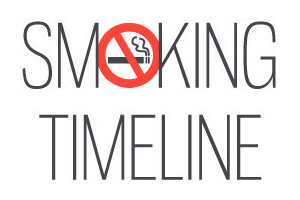Most long-time smokers enjoy cigarettes despite the health risks. But if they need a little motivation to stop, seeing the quit smoking timeline and understanding what happens to the body when you quit smoking might provide an incentive to becoming a non-smoker.
Smokers are all too familiar with the satisfaction of lighting up a cigarette and feeling the soothing sensation of nicotine flowing through the body. That feel-good moment is actually nicotine triggering the flow of dopamine in the brain, which causes the sensation of pleasure.

After all, people who smoke don’t miss work because of it, they don’t steal to get a fix, and families aren’t ruined because a family member smokes.
Nonetheless, smoking cigarettes poses a major health hazard for both the smoker and the people near them when they light up. We’ve known this for years and people are finally starting to get the message. Tobacco companies are finding it more difficult to recruit new smokers because of the social stigma attached to cigarettes and because people know it’s truly bad for the body.
While nicotine is one part of the health problem, the smoke and other additives from cigarettes may pose the greatest threat. The best way to quit smoking cigarettes for many people is to quit cold turkey altogether – have one last puff and be done.
What Are the Positive Side Effects on the Quitting Smoking Timeline?
Many people are afraid of the side effects of quitting smoking. What happens after 3 days of not smoking? Or a week, or a month?
To get an idea of what happens to the body when a person quits smoking, we turn our attention to the quit smoking timeline below that illustrates some amazing numbers about returning to better health.
If more smokers understood how well the body can heal itself, we might see more people stop.
The side effects are all positive when somebody quits smoking. Initial effects begin in as little as 20 minutes and continue for 15 years.
Soon after stopping, blood pressure returns to normal, carbon monoxide drops, and chances of heart attacks decrease, as well as that of having a stroke and developing lung disease.
To see this Quit Smoking Timeline in a larger format, visit Daily Infographic.
The Quit Smoking Timeline in a Nutshell
The source of the Quit Smoking Timeline infographic presented here is Stop Smoking at Stanford University. For those interested in learning how to give up smoking, Stanford Medicine has a Tobacco Prevention Toolkit with information about all forms of tobacco products.
Within 20 minutes of the last puff after quitting smoking, blood pressure, body temperature, and pulse rate will drop to normal. In only 20 minutes.
Approximately 8 hours later in the day, carbon monoxide levels in the blood drop, and oxygen levels return to normal. Oh yeah, and “smokers breath” disappears.
After the first day of not smoking, the chance of a heart attack is reduced.
In as little as two days of not smoking cigarettes, a person’s sense of smell and taste will improve, and nerve endings in the body can begin to regroup.
What happens after 3 days of not smoking? Breathing becomes much easier and it’s now possible for some people to commence running again without wheezing.
Two to three months later, blood circulation improves making it easier to go for long walks because lung capacity is increased by up to 30 percent.
Depending on how many cigarettes a person smoked each day, and how many years they smoked, in a period of one to nine months, the body will become healthier. Sinus congestion is reduced, and the Cilia in the lungs will start to grow back, providing a better filtration system for clearing the lungs of mucus. A positive side effect is a reduction in the chances of infection.
At the same time, many people will notice an increase in energy, making it easier to exercise and become even healthier.
Smoking Cessation Timeline After One Year
One year later, according to the stop smoking timeline, the risk of coronary heart disease is cut in half, compared to that of a person who still smokes cigarettes.
Within two years of not smoking, the risk of having a heart attack is almost back to normal.
Sometime within five years of giving up smoking a pack of cigarettes a day, the death rate from cancer is slashed by 50 percent. In fact, the chances of developing certain types of cancer, like mouth, throat, or esophageal cancer or cut in half as well.
After five years of not smoking, the chances of having a stroke are greatly reduced.
10 Years After Quitting Smoking
The quitting smoking timeline shows that sometimes within 10 years of being a non-smoker, the lung cancer death rate returns to the same probability as a person who is not a smoker. In addition, it is presumed that precancerous cells have already been replaced by healthier ones at this stage.
By the time a person has not smoked cigarettes for 15 years, the risk of coronary heart disease returns to normal levels.
How Does This Compare to Vaping or Smoking Marijuana?
The quit smoking timeline shown here is based on study data related to cigarettes, tobacco, and nicotine.
Vaping and eCigarettes pose a different set of problems with a unique set of variables. Some people vape nicotine, while others vape without nicotine. Additionally, there are some who vape marijuana as well as nicotine.
E-cigarettes and vaping have become a concerning issue for teens and young adults, as they have become addicted to them as easily as those before them who got hooked on cigarettes. But the good news is there are many benefits of quitting vaping just like with cigarettes.
With regards to marijuana, there haven’t been many studies done yet to know the dangers of cannabis smoke on the lungs or the rest of the body.
Because marijuana is still classified as a Schedule I drug by the federal government, this classification makes it difficult for any studies to be performed.
There are many known negative effects of marijuana and in due time, we will soon have a better picture of the positive and negative effects of smoking marijuana.
Many people will consider this quit smoking timeline of cigarettes to closely resemble similar results and benefits when compared to quitting vaping and marijuana.
Hopefully, the information presented here will provide some motivation for those on the fence about why they should quit smoking and what types of health benefits they can expect after they stop.
Related:
Teens Now Smoke More Marijuana Than Cigarettes
How Does Addiction Alter the Brain?
We Were Wrong About Smoking – It’s Worse Than We Thought







